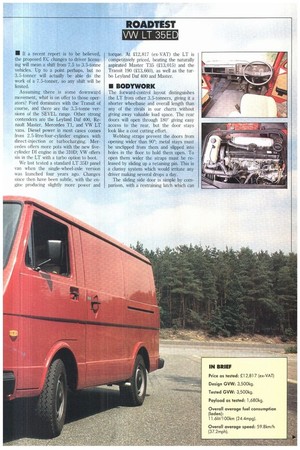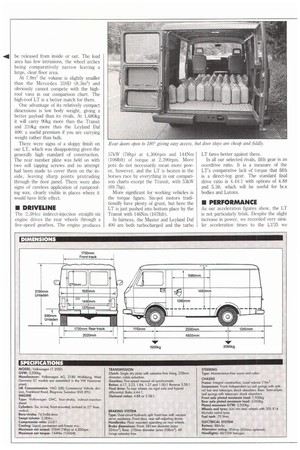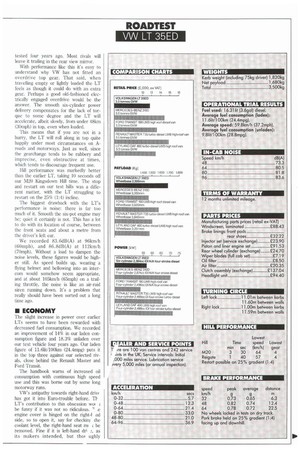ROADTEST
Page 31

Page 32

Page 33

Page 34

If you've noticed an error in this article please click here to report it so we can fix it.
IMENNE
• If a recent report is to be believed, the proposed EC changes to driver licensing will mean a shift from 7.5 to 3.5-tonne vehicles. lip to a point perhaps, but no 3.5-tonner will actually be able do the work of a 7.5-tonner, so any shift will be limited.
Assuming there is some downward movement, what is on offer to those operators? Ford dominates with the Transit of course, and there are the 3.5-tonne versions of the SEVEL range. Other strong contenders are the Leyland Daf 400, Renault Master, Mercedes T1, and VW LT vans. Diesel power in most cases comes from 2.5-litre/four-cylinder engines with direct-injection or turbocharging. Mercedes offers more pots with the new fivecylinder DI engine in the 310D; VW offers six in the LT with a turbo option to boot.
We last tested a standard LT 351) panel van when the single-wheel-axle version was launched four years ago. Changes since then have been subtle, with the engine producing slightly more power and
torque. At £12,817 (ex-VAT) the LT is competitively priced, beating the naturally aspirated Master T35 (213,015) and the Transit 190 (E13,660), as well as the turbo Leyland Daf 400 and Master.
The forward-control layout distinguishes the IT from other 3.5-tonners, giving it a shorter wheelbase and overall length than any of the rivals in our charts without giving away valuable load space. The rear doors will open through 180° giving easy access to the rear, but the door stays look like a cost cutting effort.
Webbing straps prevent the doors from opening wider than 90°; metal stays must be unclipped from them and slipped into holes in the floor to hold them open. To open them wider the straps must be released by sliding up a retaining pin. This is a clumsy system which would irritate any driver making several drops a day.
The sliding side door is simple by comparison, with a restraining latch which can
be released from inside or out. The load area has few intrusions, the wheel arches being comparatively narrow leaving a large, clear floor area.
At 7.9m3 the volume is slightly smaller than the Mercedes 310D (8.3m3) and obviously cannot compete with the highroof vans in our comparison chart. The high-roof LT is a better match for them.
One advantage of its relatively compact dimensions is low body weight, giving a better payload than its rivals. At 1,680kg it will carry 90kg more than the Transit and 210kg more than the Leyland Daf 400; a useful premium if you are carrying weight rather than bulk.
There were signs of a sloppy finish on our LT, which was disappointing given the generally high standard of construction. The rear number plate was held on with two self tapping screws and no attempt had been made to cover them on the inside, leaving sharp points protruding through the door panel. There were also signs of careless application of rustproofing wax, clearly visible in places where it would have little effect.
• DRIVEUNE
The 2,384cc indirect-injection straight-six engine drives the rear wheels through a five-speed gearbox. The engine produces 57kW (7811p) at 4,300rpin and 144Nm (106lbft) of torque at 2,200rpm. More pots do not necessarily mean more power, however, and the LT is beaten in the horses race by everything in our comparison charts except the Transit, with 53kW (69.7hp).
More significant for working vehicles is the torque figure. Six-pot motors traditionally have plenty of grunt, but here the LT is just pushed into bottom place by the Transit with 146Nm (107lbft).
In fairness, the Master and Leyland Daf 400 are both turbocharged and the turbo LT fares better against them.
In all our selected rivals, fifth gear is an overdrive ratio. It is a measure of the LT's comparative lack of torque that fifth is a direct-top gear. The standard final drive ratio is 4.44:1 with options of 4.88 and 5.38, which will he useful for bcx bodies and Lutons.
• PERFORMANCE
As our acceleration figures show, the LT is not particularly brisk. Despite the slight increase in power, we recorded very similar acceleration times to the LT35 we tested four years ago. Most rivals will leave it trailing in the rear view mirror.
With performance like this it's easy to understand why VW has not fitted an overdrive top gear. That said, when travelling empty or lightly loaded the LT feels as though it could do with an extra gear. Perhaps a good old-fashioned electrically engaged overdrive would be the answer. The smooth six-cylinder power delivery compensates for the lack of torque to some degree and the LT will accelerate, albeit slowly, from under 48km (30mpli) in top, even when loaded.
This means that if you are not in a hurry, the LT will roll along in top quite happily under most circumstances on Aroads and motorways. Just as well, since the gearchange tends to be rubbery and imprecise, even obstructive at times, which tends to discourage frequent use.
Hill performance was markedly better than the earlier LT, taking 10 seconds off our M20 Kingsdown Hill time. The stop and restart on our test hills was a different matter, with the LT struggling to restart on the 25% (1:4) incline.
The biggest drawback with the LT's performance is noise: there is far too much of it. Smooth the six-pot engine may be; quiet it certainly is not This has a lot to do with its location of course, between the front seats and about a metre from the driver's left ear.
We recorded 83.6dB(A) at 96km/h (60mph), and 86.8dB(A) at 112km/h (70mph). Without a load to dampen the noise levels, these figures would be higher still. As speed builds up, wearing a flying helmet and bellowing into an intercom would somehow seem appropriate, and at about 105km/h (65mph) on a trailing throttle, the noise is like an air-raid siren running down. It's a problem that really should have been sorted out a long time ago.
• ECONOMY
The slight increase in power over earlier LTs seems to have been rewarded with decreased fuel consumption. We recorded an improvement of 14% in our laden consumption figure and 18.3% unladen over our test vehicle four years ago. Our laden figure of 11.61k/100km (24.4mpg) puts it in the top three against our selected rivals, close behind the Renault Master and Ford Transit.
The handbook warns of increased oil consumption with continuous high speed use and this was borne out by some long motorway runs.
VW's antipathy towards right-hand drivr has got it into Euro-trouble before. TI' LT's contribution to this obsession woi be funny if it was not so ridiculous. ,e engine cover is hinged on the right-1 nd side, so to open it, say for checkini the coolant level, the right-hand seat mi t be removed. Fine if it is left-hand dri .:, as its makers intended, but thoi ughly irritating if you happen to be British.
The simple solution would be to hinge the engine cover at the front or back, which begs the question, why was it not designed that way in the first place? The situation is alleviated to a degree with an inspection flap at the back of the cover giving access to dipstick and oil filler. Access to the top of the engine is good with the cover removed and most routine service items are easily reached.
• HANDLING
Maintaining the right balance between ride and roadholding is difficult enough with a car. With a good vehicle, where the gross weight and weight distribution are constant variables, the problem is much greater. The LT is independently sprung at the front on coil springs with telescopic dampers. The rear axle is mounted on semi-elliptic leaf springs, again with telescopic dampers — a fairly standard arrangement.
The VW suspension engineers got all their sums right and the result is a vehicle with a good ride laden and unladen, combined with good, safe roadholding.. This has presumably helped the steering weight too. Some vans have much heavier steering when loaded, but again VW appears to have got it right with the LT, and the increased weight barely merits a mention.
Its stability is a marked contrast to the rear-engined Transporter, the LT offering a high degree of stability under most conditions. Strong crosswinds on a motorway did upset its poise, but then the weather was also causing problems for every other van we saw. The vacuum servo assisted discidrum brakes had a slightly spongey feel but worked well in practise. In our panic stop testing procedure the LT pulled up straight each time with muted squealing from the tyres but no obvious signs of locking up. The pull-up handbrake is located to the right of the driver's seat, like Rootes Group cars of yore. It struggled to hold the LT on the 1:4 test hill, but it is a good position for a handbrake, leaving the left hand free to operate the gearlever and allowing better co-ordination. Manufacturers fitting umbrella types should take note of this.
• INTERIOR
The interior is just as it was in our previous test four years ago. The wide cab has large comfortable seats with plenty of room for driver and passenger. There is a door pocket each side and some stowage space in the dash on the passenger side. The deep windscreen and large door mirrors give good all round visibility and the LT is very easy to place, helped by its comparatively short body.
Two column stalks control the indicators and headlamp dip/flash to the left, with two-speed wiper plus intermittent and screen wash on the right. Instrumentation is limited to a speedometer and clock with integrated fuel and temperature gauges, supplemented by a bank of warning lights over the clock.
The heater controls are identical to those we criticised in our recent Transporter Catalyst test, except that the slides are mounted vertically, revealing the logic behind the positions. The distribution control for the windscreen is up in the fully open position and that for the footwells is down, the levers pointing in the direction of the air flow when fully opened.
The fascia is in traditional VW black, relieved by the beige door panels and seat backs. Seat facings are in a tweed pattern cloth. Equipment is fairly basic with cigar lighter and manual-tune stereo radiocassette; the latter locked into a losing battle with engine noise.
• SUMMARY
Taken overall, the LT is a good van. It is good in areas like payload and handling, while offering competitive fuel consumption and good load access. For those who need more oomph, the turbo-diesel should answer our criticisms.
It's the seemingly little things that would make it irritating to live with — the gearchange, rear door stays and the furniture removal to get at the engine.
If it is to be viewed as a serious prospect for long distance work, which is the reasoning behind the five-cylinder engine in the Mercedes-Benz 310D, the noise factor leaves it badly flawed. There can't be many drivers who would put up with the sustained high noise levels of motorway work for long.
On that basis, the LT's established presence in the 3.5-tonne market place may not be enough to attract future downsizing 7. 5-tonner operators, which would be a pity, given its virtues. We think it must be worth ironing out the faults to broaden the LT's appeal. A facelifted model would be a good stablemate for the new Transporter, when it arrives.
III by John Kendall












































































































